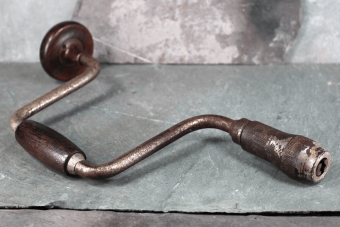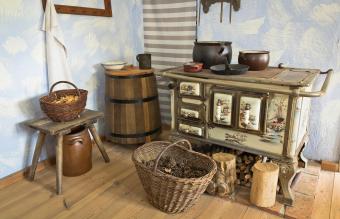
It's wild how looking at one piece of furniture can send you right back to being a little kid and spending time in your grandparent's house. Thanks to skilled carpenters and woodworkers, we get the luxury of passing down furniture that'll hold up for decades. Old furniture was just built differently, and without the many antique woodworking tools at the craftworkers' disposal, we wouldn't have the dressers, tables, desks, and chairs we love so much. Discover the many tools these artisans used to craft gorgeous furniture that has lasted for generations.
Guide to Antique Woodworking Tools

The best way of exploring an antique store isn't with an item in mind but by picking up whatever catches your eye, checking the price tag, and bringing that new addition home. The only challenge with this popular method for collecting is it leaves you with a dresser, table, and cabinet full of things you know nothing about. But part of what makes collecting fun is uncovering what you just bought and learning if it's something you can clean up and use today - or, if you lucked out with something that's worth a fortune.
Antique woodworking tools are one of these notoriously tricky collectibles because they're ambiguous to anyone who doesn't work with wood. Specialty tools are created for specific purposes that laypeople aren't familiar with, but thankfully, the most common old woodworking tools aren't all that hard to figure out if you know a few things to look for.
Wood Chisel

Chisels might feel like an old-school tool, but they still have their uses. They can scrape off glue and residue, cut corners, indent patterns, and more. Wood chisels are easy to identify because they only have two basic parts: the handle and the blade. Handles were usually round and made of wood, and the blades come to a beveled end. Either straight edged or angular, these tools run the gamut of prices.
Wood Plane

Wood planes are super important tools because they use a blade to smooth the wood down, carve out sections for framing, and more. Typically, antique wood planes come with a handle or a knob on the front that you can use to stabilize and move them. Their most identifying characteristic is the metal razor and open space where you can see the wood being cut and the chips exiting the plane.
Out of all antique woodworking tools, planes are some of the most expensive. High-quality, refurbished planes can sell for thousands of dollars because they're built to last and still do a great job at what they were designed for.
Hand Drill

Thanks to power tools, we don't have to overwork our muscles using hand drills anymore, but woodworkers weren't so lucky and had to use them to drill every type of hole. Some hand drills have a distinctive harsh U-shape. In the middle of the U is usually a worn wooden piece for your hand to grip, while one end has a rounded knob to push into the wood with, and the other end has a sharp point. Another kind uses a rotating handle (like a fishing reel) to turn the sharp point into the wood and through it. A mixture of metal and wood, these tools came in a variety of sizes.
Try Square

Try squares are old measuring tools used to mark and check 90° angles on pieces of wood. Antique versions are usually unadorned and simply made, with one wood rectangle and one metal rectangle joined at the base with a screw or two to form a perfect right angle. Even in rough condition, they can sell for about $50, like this one from the 1930s-40s that's listed for $52.
Awls

Awls are uncomplicated tools that're still used today. With a knob on the end that comes in various shapes and sizes and a sharp metal rod that sticks out of it, woodworkers use awls to inscribe lines along the wood grain. They're quaint, small, and pretty easy to find on the market. Because of how many are out there, you can get them fairly cheaply online and in antique stores.
Two Old Woodworking Tool Manufacturers
Over the years, many woodworking manufacturers have risen to prominence because of their innovative designs and high-quality construction. Some of these names continue to create tools for customers like you today, but others are less familiar. Either way, two manufacturers are highly collectible, and you want to look for anything made by them.
- Stanley Tool and Level Co.
- T. Norris and Son
How Much Are Antique Woodworking Tools Worth?
It might come as a huge shock because most of us get our furniture through mass-market production and can't imagine there being a lot of people hand making furniture in their garages. But, for how small and industrious they are, antique woodworking tools are worth a good bit. Rare, one-of-a-kind pieces from before the 19th century will sell in the thousands. But, frequently, well-known manufacturers and well-preserved pieces will sell in the $500-$1,000 range.
Largely, wood planes are the biggest draw for serious woodworkers and tool collectors. There are just so many different types that people pay a lot for them. Similarly, even small tools like awls can fetch a couple hundred when they're in a good condition. This means that they're not rusted and they've been cleaned, polished, and (in some cases) sharpened. That being said, antique stores and thrift shops almost always price their antique woodworking tools lower than places do online, so you can get a couple of pieces for under $25 or $50 if you find them in-person.
Take how much these antique woodworking tools are listed for online, for example:
- This Norris No. 31 brass and steel thumb wood plane from the 1920s-1930s recently sold for $5,5000. Norris was considered an exquisite wood plane maker, and their tools were costly even at the time they were made. In a great condition like this, it's no wonder that it would command a high price.
- Measurement tools rarely bring in the same high prices that manual ones do. That's because the quality or shape of the tool you use doesn't affect measuring as long as it's accurate. For example, this antique Stanley try-square only sold for around $25 on eBay.
Using Antique Woodworking Tools on Modern Projects
You can absolutely use antique woodworking tools on modern projects, so long as they're not rusted and they have all of their parts and are sharpened/cleaned. You can use typical wood cleaners and oils, as well as stainless steel cleaners, to bring your tools back to life.
Working With Your Hands Never Gets Old
Humans like a tactile experience; it's why woodworking hasn't gone completely corporate yet. But you don't have to be a woodworker to appreciate the intimacy of holding an old artisan's tool in your hands. Not only do they make for cool collectibles, but they're also super useful. If you've got any woodworkers, carpenters, or cabinetmakers in your circle, getting them an antique woodworking tool as a gift is a must.







